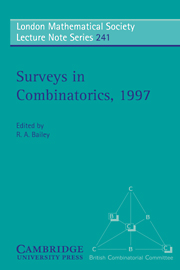Book contents
- Frontmatter
- Contents
- Preface
- M13
- The Harmonious Chromatic Number and the Achromatic Number
- Computer Construction of Block Designs
- Finite Quasiprimitive Graphs
- Tree Width and Tangles: A New Connectivity Measure and Some Applications
- Minor-monotone Graph Invariants
- Some Applications of Algebraic Curves in Finite Geometry and Combinatorics
- New Perspectives on Interval Orders and Interval Graphs
- Approximate Counting
- Author Index
- Subject Index
Tree Width and Tangles: A New Connectivity Measure and Some Applications
Published online by Cambridge University Press: 29 March 2010
- Frontmatter
- Contents
- Preface
- M13
- The Harmonious Chromatic Number and the Achromatic Number
- Computer Construction of Block Designs
- Finite Quasiprimitive Graphs
- Tree Width and Tangles: A New Connectivity Measure and Some Applications
- Minor-monotone Graph Invariants
- Some Applications of Algebraic Curves in Finite Geometry and Combinatorics
- New Perspectives on Interval Orders and Interval Graphs
- Approximate Counting
- Author Index
- Subject Index
Summary
Summary We discuss tree width, a new connectivity invariant of graphs defined by Robertson and Seymour. We present a duality result and a canonical decomposition theorem tied to this invariant. We also discuss a number of applications of these results, including Robertson and Seymour's Graph Minors Project.
Introduction
A taste of things to come
A graph is a set of vertices and an adjacency relation which indicates which pairs of vertices are joined by an edge. Thus, graph theory is essentially the study of connectivity. How then does one measure the connectivity of a graph?
Measuring the connectivity between two vertices is straightforward. Two vertices are said to be k-connected if there are k internally vertex disjoint paths between them. A classical theorem of Menger [30] states that vertices a and b are k-connected in a graph G precisely if there is no set X of fewer than k vertices such that a and b lie in different components of G – X. Standard alternating paths techniques, see e.g. [21], allow us to find either k internally vertex disjoint a-b paths or such a set X efficiently.
An appropriate definition of a highly connected graph, or of a highly connected piece of a graph is more difficult. The classical approach is to call a graph k-connected if every pair of its vertices is k-connected. This definition, although natural, does not capture the kind of connectivity that will concern us. It focuses on local properties rather than global ones.
Information
- Type
- Chapter
- Information
- Surveys in Combinatorics, 1997 , pp. 87 - 162Publisher: Cambridge University PressPrint publication year: 1997
Accessibility standard: Unknown
Why this information is here
This section outlines the accessibility features of this content - including support for screen readers, full keyboard navigation and high-contrast display options. This may not be relevant for you.Accessibility Information
- 42
- Cited by
